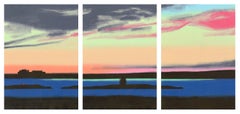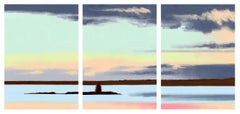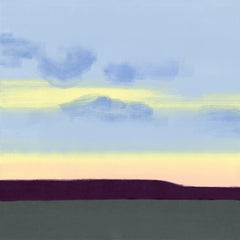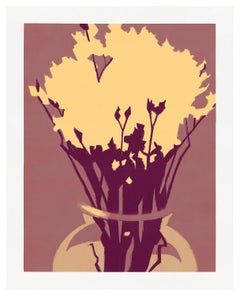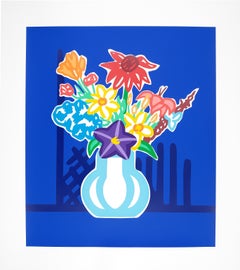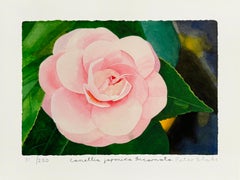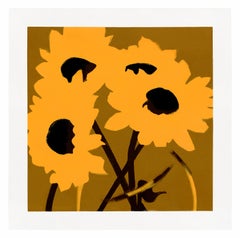Rachel Burgess Prints and Multiples
American
Rachel Burgess is a visual artist based in New York. Originally from Boston, she received a B.A. in Literature from Yale University and an M.F.A. in Illustration from the School of Visual Arts. Her interest in narrative and sequential forms continues to inform her work. She is the recipient of a 2021 Artist Development Program Award from the International Print Center of New York (NY); previous solo/two-person exhibitions include 3S Artspace (NH), Susan Eley Fine Art (NY), the University of Connecticut Art Gallery in Stamford (CT) and the Jonathan Frost Gallery (ME); previous group exhibitions include the International Print Center of New York (NY), 20/20 Gallery at the Elizabeth Foundation for the Arts (NY), the Newhouse Center for Contemporary Art (NY), the Monmouth Museum (NJ), the South Bend Museum of Art (IN), the American University Museum (Washington, D.C.), the Pyramida Center for Contemporary Art (Israel) and the Seoul Museum of Art (Korea). Burgess’ work has been supported by residencies at Acadia National Park and Zea Mays Printmaking, and has been featured in the New York Times, the Boston Globe, Drawing Magazine, Introspective Magazine, 3x3 Magazine and CMYK.
The coast of Maine has been the main source of inspiration for Rachel Burgess for many years. Using monotype, she creates iconic scenes that explore the relationship between experience and myth. By editing, abstracting, printing and reversing her landscapes, she gives physical form the process we perform internally when we convert our lives into stories. The results are places as seen through the mind’s eye, fabricated versions of real scenes.
To make her work, Burgess begins by drawing outdoors, on location. She doesn’t use photographs because she wants to honor her instinctual editing choices, capturing her reaction to a place, rather than the place itself. Afterwards, in a print studio, she makes monotypes based on her drawings. Monotype is a form of printmaking that yields just one image. To make a monotype, Burgess applies oil-based ink to plexiglass plates, using rollers, Q-tips, tarlatan, paper towels and bits of cardboard to add and remove colors. The creation of the image must be accomplished in a day because the ink dries quickly. The pulling of the print, which takes a few minutes, is followed by a wiping away of the image from the plate. The initial “painting” is lost, and a new work on paper is created, mimicking the way we transform fleeting experiences into lasting stories. The final product is a mirror image of the original, a metaphor for the fictionalization and abstraction that occurs in our minds.(Biography provided by Susan Eley Fine Art)
to
14
2
6
5
3
2
5
7
Overall Height
to
Overall Width
to
9
5
9
9
5
5
5
4
4
4
3
3
3
3
3
2
2
2
2
2
1
1
14
26
990
724
663
630
12
5
4
Artist: Rachel Burgess
Red Light, Landscape, Seascape, red, blue, green, yellow, dark colors, triptych
By Rachel Burgess
Located in New York, NY
Monotype on three sheets of paper
Unframed
Rachel Burgess is a visual artist based in New York. Originally from Boston, she received a B.A. in Literature from Yale University and a...
Category
2010s Contemporary Rachel Burgess Prints and Multiples
Materials
Monotype
Blue Shadow, landscape, glue, gray, orange, pastel, seascape, nature, triptych
By Rachel Burgess
Located in New York, NY
Monotype on three sheets of paper
Unframed
Rachel Burgess is a visual artist based in New York. Originally from Boston, she received a B.A. in Literature from Yale University and an...
Category
2010s Contemporary Rachel Burgess Prints and Multiples
Materials
Monotype
Five Blue Clouds
By Rachel Burgess
Located in New York, NY
"Five Blue Clouds, monotype, 27" x 27", 2022, $1500 unframed
Category
2010s Contemporary Rachel Burgess Prints and Multiples
Materials
Monotype
Gulls
By Rachel Burgess
Located in New York, NY
"Gulls", monotype, 28" x 39", 2020, $2200 unframed
Category
2010s Contemporary Rachel Burgess Prints and Multiples
Materials
Monotype
Unknown Flower
By Rachel Burgess
Located in New York, NY
Love / Bouquet / Flowers / Couple
Artist Statement
Rachel Burgess makes autobiographical works on paper of landscapes and domestic scenes. Window-like in scale, her pieces combine...
Category
2010s Pop Art Rachel Burgess Prints and Multiples
Materials
Monotype
Daisies IX (Red Daisies)
By Rachel Burgess
Located in New York, NY
Artist Statement
Rachel Burgess makes autobiographical works on paper of landscapes and domestic scenes. Window-like in scale, her pieces combine elements of oil painting, folk art ...
Category
2010s Pop Art Rachel Burgess Prints and Multiples
Materials
Monotype
Bud Vase II
By Rachel Burgess
Located in New York, NY
Install images by Em Joseph
Artist Statement
Rachel Burgess makes autobiographical works on paper of landscapes and domestic scenes. Window-like in scale, her pieces combine elemen...
Category
2010s Pop Art Rachel Burgess Prints and Multiples
Materials
Paper, Monotype
Daisies III (Dark Daisies)
By Rachel Burgess
Located in New York, NY
Artist Statement
Rachel Burgess makes autobiographical works on paper of landscapes and domestic scenes. Window-like in scale, her pieces combine elements of oil painting, folk art and commercial illustration, exploring our attempts to impose narratives on our lives. Attracted by the accessible, democratic nature of printmaking, she works primarily in monotype, straddling the divide between popular and elite forms of storytelling.
“Deli Flowers My Husband Bought Me” is based on flowers that Burgess’ husband, an NYPD detective, has brought home over the years from their local corner deli. Through iconic renderings of these simple gifts, Burgess pays tribute to the things we take for granted – to the city, to its essential workers...
Category
2010s Pop Art Rachel Burgess Prints and Multiples
Materials
Monotype
Pink Snow, winter landscape, monotype on paper
By Rachel Burgess
Located in New York, NY
From the "100 Views of the Piscataqua" series.
The coastal landscapes of Maine have been the main source of inspiration for Rachel Burgess for many years. Burgess’s ongoing fascinat...
Category
2010s Contemporary Rachel Burgess Prints and Multiples
Materials
Paper, Monoprint
Winter, monoprint of river during the day, snow, pastel blue and pink
By Rachel Burgess
Located in New York, NY
The coast of Maine, and in particular the river Piscataqua near Rachel Burgess’ childhood vacation home, has been the artist’s muse since the start of her career. Burgess’ stunning, ...
Category
2010s Contemporary Rachel Burgess Prints and Multiples
Materials
Paper, Monoprint, Monotype
Pink Lake, square abstract monoprint
By Rachel Burgess
Located in New York, NY
The coastal landscapes of Maine have been the main source of inspiration for Rachel
Burgess for many years. Burgess’s ongoing fascination with how land meets water—
along rivers, lak...
Category
2010s Contemporary Rachel Burgess Prints and Multiples
Materials
Monoprint, Paper, Monotype
Hudson. 2018, green montoype on two sheets of paper. Diptych landscape.
By Rachel Burgess
Located in New York, NY
Rachel Burgess' landscapes are explorations of memory and the resonance of nature's forms. She begins her artistic process with plein air paintings and drawings which she completes i...
Category
2010s Contemporary Rachel Burgess Prints and Multiples
Materials
Monotype, Paper
Bloom, spring day, green fields with trees, landscape diptych, monoprint
By Rachel Burgess
Located in New York, NY
Bloom (2017)
Rachel Burgess
Monoprint on two sheets of paper, 39 x 56 inches total
This work is framed.
Category
2010s Contemporary Rachel Burgess Prints and Multiples
Materials
Monoprint
Lilies I
By Rachel Burgess
Located in New York, NY
Artist Statement
Rachel Burgess makes autobiographical works on paper of landscapes and domestic scenes. Window-like in scale, her pieces combine elements of oil painting, folk art ...
Category
2010s Pop Art Rachel Burgess Prints and Multiples
Materials
Monotype
Related Items
UNICEF Bouquet - Tom Wesselmann, Pop Art, Still-life, Print, Screenprint
By Tom Wesselmann
Located in London, GB
Screenprint in colours, 1998.
From 'Meine Kindheit - Schmerz und Heilung, UNICEF'.
Signed in pencil, numbered from the edition of 100.
Image: 63.5 x 54.5 cm Sheet: 78.8 x 70 cm
Category
1990s Pop Art Rachel Burgess Prints and Multiples
Materials
Screen
Camellia Japonica Incarnata
By Peter Blake
Located in London, GB
Archival digital print on wove paper. Edition 31/250. Printed by Coriander Press. Published by Chiswick House and Gardens. Signed and numbered by the artist.
Category
2010s Pop Art Rachel Burgess Prints and Multiples
Materials
Digital Pigment
The Red One, Sweet Art, Quality Street Artwork, Still Life Artwork, Food Art
By Simon Dry
Located in Deddington, GB
Limited edition print of the original ‘The Red One’ Quality Street Strawberry Cream image by Simon Dry. The first print onto Fabriano paper is over painted in white by Simon and then over printed again to create a uniquely textured hand finished surface. Each print becomes a richly coloured and individual piece of art in a limited edition of 50, signed and numbered by the artist.
Simon Dry original art and prints available online and in the gallery at Wychwood Art. Simon Dry trained as a graphic designer, graduating with a BA (Hons) from Ravensbourne College of Art & Design. He has run Drydesign in London, Dublin and Suffolk, using skills learned in this time to create SweetArt along with his wife, Vic. Artist Simon Dry has created highly original art of much loved sweets, made solely from discarded Quality Street wrappers. These iconic artworks feature Dolly Mixture, Fab ice lolly...
Category
2010s Pop Art Rachel Burgess Prints and Multiples
Materials
Paper, Screen
H 18.12 in W 25.2 in D 0.04 in
"Paricutin (Volcano in Michoacan, Mexico)" Woodcut & Monotype signed by Summers
By Carol Summers
Located in Milwaukee, WI
"Paricutin (Volcano in Michoacan, Mexico)" is a woodcut and monotype signed by Carol Summers. In the image, an abstracted volcano erupts in a joyous burst of purples and oranges. The playfulness of the image is enhanced by Summers' signature printmaking technique, which allows the ink from the woodblock to seep through the paper, blurring the edges of each form.
Art: 8 x 11 in
Frame: 17 x 19 in
Carol Summers (1925-2016) has worked as an artist throughout the second half of the 20th century and into the first years of the next, outliving most of his mid-century modernist peers. Initially trained as a painter, Summers was drawn to color woodcuts around 1950 and it became his specialty thereafter. Over the years he has developed a process and style that is both innovative and readily recognizable. His art is known for it’s large scale, saturated fields of bold color, semi-abstract treatment of landscapes from around the world and a luminescent quality achieved through a printmaking process he invented.
In a career that has extended over half a century, Summers has hand-pulled approximately 245 woodcuts in editions that have typically run from 25 to 100 in number. His talent was both inherited and learned. Born in 1925 in Kingston, a small town in upstate New York, Summers was raised in nearby Woodstock with his older sister, Mary. His parents were both artists who had met in art school in St. Louis. During the Great Depression, when Carol was growing up, his father supported the family as a medical illustrator until he could return to painting. His mother was a watercolorist and also quite knowledgeable about the different kinds of papers used for various kinds of painting. Many years later, Summers would paint or print on thinly textured paper originally collected by his mother.
From 1948 to 1951, Carol Summers trained in the classical fine and studio arts at Bard College and at the Art Students League of New York. He studied painting with Steven Hirsh and printmaking with Louis Schanker. He admired the shapes and colors favored by early modernists Paul Klee (Sw: 1879-1940) and Matt Phillips (Am: b.1927- ). After graduating, Summers quit working as a part-time carpenter and cabinetmaker (which had supported his schooling and living expenses) to focus fulltime on art. That same year, an early abstract, Bridge No. 1 was selected for a Purchase Prize in a competition sponsored by the Brooklyn Museum.
In 1952, his work (Cathedral, Construction and Icarus) was shown the first time at the Museum of Modern Art in New York City in an exhibition of American woodcuts. In 1954, Summers received a grant from the Italian government to study for a year in Italy. Woodcuts completed soon after his arrival there were almost all editions of only 8 to 25 prints, small in size, architectural in content and black and white in color. The most well-known are Siennese Landscape and Little Landscape, which depicted the area near where he resided. Summers extended this trip three more years, a decision which would have significant impact on choices of subject matter and color in the coming decade.
After returning from Europe, Summers’ images continued to feature historical landmarks and events from Italy as well as from France, Spain and Greece. However, as evidenced in Aetna’s Dream, Worldwind and Arch of Triumph, a new look prevailed. These woodcuts were larger in size and in color. Some incorporated metal leaf in the creation of a collage and Summers even experimented with silkscreening. Editions were now between 20 and 50 prints in number. Most importantly, Summers employed his rubbing technique for the first time in the creation of Fantastic Garden in late 1957.
Dark Vision of Xerxes, a benchmark for Summers, was the first woodcut where Summers experimented using mineral spirits as part of his printmaking process. A Fulbright Grant as well as Fellowships from the Louis Comfort Tiffany Foundation and the Guggenheim Foundation followed soon thereafter, as did faculty positions at colleges and universities primarily in New York and Pennsylvania. During this period he married a dancer named Elaine Smithers with whom he had one son, Kyle. Around this same time, along with fellow artist Leonard Baskin, Summers pioneered what is now referred to as the “monumental” woodcut. This term was coined in the early 1960s to denote woodcuts that were dramatically bigger than those previously created in earlier years, ones that were limited in size mostly by the size of small hand-presses. While Baskin chose figurative subject matter, serious in nature and rendered with thick, striated lines, Summers rendered much less somber images preferring to emphasize shape and color; his subject matter approached abstraction but was always firmly rooted in the landscape.
In addition to working in this new, larger scale, Summers simultaneously refined a printmaking process which would eventually be called the “Carol Summers Method” or the “ Carol Summers Technique”. Summers produces his woodcuts by hand, usually from one or more blocks of quarter-inch pine, using oil-based printing inks and porous mulberry papers. His woodcuts reveal a sensitivity to wood especially its absorptive qualities and the subtleties of the grain. In several of his woodcuts throughout his career he has used the undulating, grainy patterns of a large wood plank to portray a flowing river or tumbling waterfall. The best examples of this are Dream, done in 1965 and the later Flash Flood Escalante, in 2003. In the majority of his woodcuts, Summers makes the blocks slightly larger than the paper so the image and color will bleed off the edge.
Before printing, he centers a dry sheet of paper over the top of the cut wood block or blocks, securing it with giant clips. Then he rolls the ink directly on the front of the sheet of paper and pressing down onto the dry wood block or reassembled group of blocks. Summers is technically very proficient; the inks are thoroughly saturated onto the surface of the paper but they do not run into each other. The precision of the color inking in Constantine’s Dream in 1969 and Rainbow Glacier in 1970 has been referred to in various studio handbooks. Summers refers to his own printing technique as “rubbing”. In traditional woodcut printing, including the Japanese method, the ink is applied directly onto the block. However, by following his own method, Summers has avoided the mirror-reversed image of a conventional print and it has given him the control over the precise amount of ink that he wants on the paper. After the ink is applied to the front of the paper, Summers sprays it with mineral spirits, which act as a thinning agent. The absorptive fibers of the paper draw the thinned ink away from the surface softening the shapes and diffusing and muting the colors. This produces a unique glow that is a hallmark of the Summers printmaking technique. Unlike the works of other color field artists or modernists of the time, this new technique made Summers’ extreme simplification and flat color areas anything but hard-edged or coldly impersonal.
By the 1960s, Summers had developed a personal way of coloring and printing and was not afraid of hard work, doing the cutting, inking and pulling himself. In 1964, at the age of 38, Summers’ work was exhibited for a second time at the Museum of Modern Art. This time his work was featured in a one-man show and then as one of MoMA’s two-year traveling exhibitions which toured throughout the United States. In subsequent years, Summers’ works would be exhibited and acquired for the permanent collections of multiple museums throughout the United States, Europe and Asia. Summers’ familiarity with landscapes throughout the world is firsthand. As a navigator-bombardier in the Marines in World War II, he toured the South Pacific and Asia.
Following college, travel in Europe and subsequent teaching positions, in 1972, after 47 years on the East Coast, Carol Summers moved permanently to Bonny Doon in the Santa Cruz Mountains in Northern California. There met his second wife, Joan Ward Toth, a textile artist who died in 1998; and it was here his second son, Ethan was born. During the years that followed this relocation, Summers’ choice of subject matter became more diverse although it retained the positive, mostly life-affirming quality that had existed from the beginning. Images now included moons, comets, both sunny and starry skies, hearts and flowers, all of which, in one way or another, remained tied to the landscape.
In the 1980s, from his home and studio in the Santa Cruz mountains, Summers continued to work as an artist supplementing his income by conducting classes and workshops at universities in California and Oregon as well as throughout the Mid and Southwest. He also traveled extensively during this period hiking and camping, often for weeks at a time, throughout the western United States and Canada. Throughout the decade it was not unusual for Summers to backpack alone or with a fellow artist into mountains or back country for six weeks or more at a time. Not surprisingly, the artwork created during this period rarely departed from images of the land, sea and sky. Summers rendered these landscapes in a more representational style than before, however he always kept them somewhat abstract by mixing geometric shapes with organic shapes, irregular in outline. Some of his most critically acknowledged work was created during this period including First Rain, 1985 and The Rolling Sea, 1989. Summers received an honorary doctorate from his alma mater, Bard College in 1979 and was selected by the United States Information Agency to spend a year conducting painting and printmaking workshops at universities throughout India. Since that original sabbatical, he has returned every year, spending four to eight weeks traveling throughout that country.
In the 1990s, interspersed with these journeys to India have been additional treks to the back roads and high country areas of Mexico, Central America, Nepal, China and Japan. Travel to these exotic and faraway places had a profound influence on Summers’ art. Subject matter became more worldly and non-western as with From Humla to Dolpo, 1991 or A Former Life of Budha, 1996, for example. Architectural images, such as The Pillars of Hercules, 1990 or The Raja’s Aviary, 1992 became more common. Still life images made a reappearance with Jungle Bouquet in 1997. This was also a period when Summers began using odd-sized paper to further the impact of an image.
The 1996 Night, a view of the earth and horizon as it might be seen by an astronaut, is over six feet long and only slightly more than a foot-and-a-half high. From 1999, Revuelta A Vida (Spanish for “Return to Life”) is pie-shaped and covers nearly 18 cubic feet. It was also at this juncture that Summers began to experiment with a somewhat different palette although he retained his love of saturated colors. The 2003 Far Side of Time is a superb example of the new direction taken by this colorist.
At the turn of the millennium in 1999, “Carol Summers Woodcuts...
Category
Early 2000s Contemporary Rachel Burgess Prints and Multiples
Materials
Woodcut, Monotype
Absolut Vodka Poster
By Andy Warhol
Located in Toronto, Ontario
Andy Warhol (1928-1987) is arguably the most important American artist of the 20th century. He not only defined Pop Art but had an unrivaled influence on artists and image-making. Th...
Category
1980s Pop Art Rachel Burgess Prints and Multiples
Materials
Lithograph, Offset
Loneliness 2 - Handmade Linocut and Monotype Techniq, Limited Edition 1/5
By Aneta Szoltis-Mencina
Located in Salzburg, AT
The artwork will be sent unframed
Linocut and Monotype print „Loneliness 2 ” 2021
Limited edition, print unique number 1/5
Paper Fabriano Rosaspina 220 g
Paper size 15,75x19,69 inch...
Category
2010s Contemporary Rachel Burgess Prints and Multiples
Materials
Paper, Linocut, Monotype
Gold Finger, Sweetie Art, Food Art, Still Life Print, Chocolate Art, Easter Art
By Simon Dry
Located in Deddington, GB
Limited edition print of the original ‘Gold Finger’ Quality Street Toffee Finger image by Simon Dry. The first print onto Fabriano paper is over painted in white by Simon and then over printed again to create a uniquely textured hand finished surface. Each print becomes a richly coloured and individual piece of art in a limited edition of 50, signed and numbered by the artist.
Simon Dry original art and prints available online and in the gallery. Simon Dry trained as a graphic designer, graduating with a BA (Hons) from Ravensbourne College of Art & Design. He has run Drydesign in London, Dublin and Suffolk, using skills learned in this time to create SweetArt along with his wife, Vic. Artist Simon Dry has created highly original art of much loved sweets, made solely from discarded Quality Street wrappers. These iconic artworks feature Dolly Mixture, Fab ice lolly...
Category
2010s Pop Art Rachel Burgess Prints and Multiples
Materials
Paper, Screen
H 18.12 in W 25.2 in D 0.04 in
Aloe Vera, Still Life Art, Floral Art, Cacti Art, Bright Art, Affordable Art
By Kerry Day
Located in Deddington, GB
A lovely spiky Still life of an Aloe Vera Plant by Kerry Day is a original varied limited edition, multi layered screen print. Printed onto Somerset paper, it has been printed to the...
Category
2010s Pop Art Rachel Burgess Prints and Multiples
Materials
Paper, Screen
Large Donald Saff Surrealist Pop Art Aquatint Etching Bee, Chair, Pot
By Donald Saff
Located in Surfside, FL
Artist: Donald Saff
Medium: Etching with Aquatint, Hand signed and numbered in pencil
Donald Jay Saff (born 12 December 1937) is an artist, art historian, educator, and lecturer, specializing in the fields of contemporary art in addition to American and English horology. Saff was born in Brooklyn, New York.
Donald Saff began his undergraduate degree at Queens College, City University of New York, in 1955, initially envisioning a career as an electrical engineer. However, the following year Saff changed his major to art and learned printmaking, to graduate with a B.A. in 1959 and a M.A. in art history from Columbia University in 1960. In the years following, Saff was awarded a M.F.A. from Pratt Institute in 1962 and an Ed.D. in studio art and art history from Columbia University in 1964. In his early career, Saff studied with Robert Goldwater, Robert Branner, Louis Hechenbleikner, and Meyer Schapiro.
Saff is primarily known for his work and collaboration with the leading artists of the late-twentieth century, including Robert Rauschenberg, Jim Dine, Roy Lichtenstein, James Rosenquist, Nancy Graves, Philip Pearlstein, and James Turrell. Saff's prolific career is the subject of Marilyn S. Kushner's book, Donald Saff: Art in Collaboration (2010). Saff began his teaching career at Queens College as a lecturer in Art History, Design, and Drawing, from 1961 to 1964. In 1965, Saff was appointed as an associate professor in the visual arts department of the University of South Florida in Tampa, Florida, and became professor and chairman of the visual arts department two years later. In 1971, Saff became the founding dean of the College of Fine Arts at U.S.F., and was awarded the rank of distinguished professor at the university in 1982. Saff was later named dean emeritus by USF in 1989, and distinguished professor emeritus in 1996. In 1999, Saff was awarded the honorary degree of Doctor of Fine Arts at U.S.F. He was appointed the Director of Capital Projects of the Solomon R. Guggenheim Foundation, New York, in 2001, followed by the appointment of Senior Curator of Prints and Drawings in 2002.
In 1968, Saff founded Graphicstudio at U.S.F. through funding by a seed grant from the Florida Arts Council and community supporters; the following year, Philip Pearlstein was the first artist invited to Graphicstudio to collaborate with Saff and his team. Saff became Founding Dean of the College of Fine Arts at U.S.F. in 1971. Under Saff's directorship, Graphicstudio collaborated with artists such as James Rosenquist, Robert Rauschenberg, Richard Anuszkiewicz, Shusaku Arakawa, Jim Dine, Lee Friedlander, Nancy Graves, Ed Ruscha, and Roy Lichtenstein. The collection of Graphicstudio is archived in the National Gallery of Art in Washington, D.C.
Graphicstudio was founded by Dr. Donald Saff as part of the renaissance in American printmaking in the 1960s, in the company of studios such as ULAE, Tamarind, and Gemini GEL. This renaissance brought artists involved in the Pop art movement, such as Robert Rauschenberg, James Rosenquist, and Jim Dine, together with a growing number of trained printmakers from around the world. After Saff retired from U.S.F., he continued to collaborate with these artists, as well as James Turrell, at Saff Tech Arts in Oxford, Maryland, which was established in 1991.
While Saff and Rauschenberg were traveling in China, Rauschenberg conceived of the Rauschenberg Overseas Culture Interchange (ROCI) in 1982, which began in 1984 with Saff as the artistic director. Saff travelled to over twenty countries and met with poets and writers in order to decide which were the most appropriate venues for the show and prepare for Rauschenberg's visit and exhibition.
In recent years, Saff has continued to lecture and write on art and the history and mechanics of nineteenth-century clocks; in particular, the work of Charles Fasoldt, in addition to the development of time distribution from the Harvard College Observatory, and the horological innovations of Richard F. Bond. He has lectured on Fasoldt for the Antiquarian Horological Association in Cincinnati, OH (2001), the National Association of Watch and Clock Collectors in Pittsburgh, PA, and Anheim, CA (2003), and at the 26th Annual Ward Francillon Time Symposium in Houston, TX (2004), among other venues. Saff continues to work with the Royal Observatory in Greenwich, collaborating with Jonathan Betts and Rory McEvoy, on the trials of Burgess Clock B. (See "Honors.")
Exhibitions
Saff's individual work spans across his career of collaborative art. As early as 1965, Saff produced Duino Elegies, a print suite that was published and exhibited by Martin Gordon Gallery in New York and at the Galleria Academia in Rome; it was acquired by the Library of Congress, the Brooklyn Museum, and Lessing Rosenwald. Saff also collaborated with printers Galli and Arduini in Urbino to create print suites Breezes (1969), exhibited and published by the Martin Gordon Gallery. Additionally, Saff collaborated with Galli on print suites Paradise Lost (1970) and Numbers (1972), the former printed in Tampa, FL, and exhibited at the Martin Gordon Gallery, the University of South Florida Gallery, the Toronto Art Gallery, and the Loch Haven Art Center, FL. Numbers was exhibited at Multiples Gallery, New York. In 1979, Saff produced print suite Fables that was published and exhibited by the Getler/Pall Gallery in New York, followed by the print suite Constellations (1980), which was also exhibited at the Tom Lutrell Gallery in San Francisco. In 1981, Saff had solo exhibitions of his artwork in the Galleria d'Arte Moderna in Udine, Italy, Youngstown State University, OH, the Leo Castelli Gallery, NY, and in "Recent Acquisitions" at The Museum of Modern Art, NY. Additionally, Saff had solo exhibitions at Dyansen Gallery, NY (1982), at I. Feldman Gallery, Sarasota (1983), and at Edison Community College, FL (1988). In 1989, the retrospective Donald Saff: Mixed Metaphors, 1956–1989 was held at the Tampa Museum of Art and traveled to the Virginia Beach Center for the Arts, followed by his solo exhibition Winged Metaphors: Sculpture and Prints by Donald Saff at the Barbara Gillman Gallery in Miami later that year. In 1997, Brenau University Galleries exhibits Poetics: The Work of Donald Saff in Gainesville, GA. The same year, the Tampa Museum of Art exhibited Donald Saff/Robert Rauschenberg: In Collaboration. Finally, the Academy Art Museum in Easton, MD, exhibited Donald Saff: Gravity and Constellations; Selected Works in 2006.
Honors
Saff was awarded a Teaching Fellowship at Queens College (1960), a Yaddo Fellowship, Saratoga Springs, NY (1963), and Fulbright Fellowship (1964) to Italy where he studied at Istituto Statale di Belle Arti. While in Urbino, Saff met lifelong friend and colleague Deli Sacilotto, with whom he would co-author Printmaking: History and Process (1978) and Screenprinting: History and Process (1979). He received the Governor's Award for the Arts from the State of Florida in 1973, and was awarded the Florida Endowment for the Arts Individual Artist Grant in 1980. In 1997, Saff was awarded the title "Printmaker Emeritus" by the 25th Southern Graphics Council Conference in Tampa, F.L. In 2002, he was appointed as Visiting Distinguished Professor of Rhode Island School of Design.
In April 2015, Saff was awarded a certificate from the Guinness World Records for his work on completing the world's most accurate pendulum clock, "Clock B", which was started by Martin Burgess in 1975. The official title awarded by Guinness World Records, as "the most accurate mechanical clock with a pendulum...
Category
1980s Pop Art Rachel Burgess Prints and Multiples
Materials
Etching, Aquatint
Stuffed Pheasant, Pop Art Screenprint by Hunt Slonem
By Hunt Slonem
Located in Long Island City, NY
Artist: Hunt Slonem, American (1951 - )
Title: Stuffed Pheasant
Year: 1980
Medium: Serigraph, signed and numbered in pencil
Edition: AP 24
Image ...
Category
1980s Pop Art Rachel Burgess Prints and Multiples
Materials
Screen
R.B. Kitaj Screenprint Collage Hand Signed British Pop Art Film Still Camel
By Ronald Brooks Kitaj
Located in Surfside, FL
The Most Important Film Ever Made, 1972
Color screen print and collage, from the edition of 70.
15 x 17 in
38.1 x 43.2 cm
Published by the artist with Marlborough Graphics at the Kelpra studio in 1972. This work is also in the collections of TATE London and the Victoria & Albert Museum. the price reflects the fact that there is no backing page.
Stylistically, these are hybrid works, influenced by Pop art and the modernist tradition of the Readymade, a work of art created when a mundane found object is named as an artwork and set in an art context. This avant-garde concept was originally invented by the Dada master Marcel Duchamp early in the twentieth century. In the 1960s it received renewed attention at a time when artistic norms were again being questioned. Reacting to Andy Warhol’s Pop imagery, Kitaj poignantly called his repurposed lithograph and silkscreen book covers “his soup can, his Liz Taylor.” The blatant use of images taken directly from commercial sources situates In Our Time as a precursor of appropriation art. In turning book covers into works of art, Kitaj is offering fragments of a history of knowledge, in which the content of each volume is at once mysterious and absent. Coming from this passionate bibliophile, the series is nothing less than an intellectual self-portrait.
R.B. Kitaj, in full Ronald Brooks Kitaj . Ron Kitaj...
Category
1960s Pop Art Rachel Burgess Prints and Multiples
Materials
Screen
Tiepolo Clouds
By Zolita Sverdlove
Located in Dallas, TX
Inscribed "Tiepolo Clouds" at lower left, "A. P." at lower center and signed "Zolita Sverdlove '85" at lower right
This monotype is printed on BFK Rives paper
Category
1980s Contemporary Rachel Burgess Prints and Multiples
Materials
Monotype
Previously Available Items
Bud Vase IV
By Rachel Burgess
Located in New York, NY
Artist Statement
Rachel Burgess makes autobiographical works on paper of landscapes and domestic scenes. Window-like in scale, her pieces combine elements of oil painting, folk art ...
Category
2010s Pop Art Rachel Burgess Prints and Multiples
Materials
Monotype
Lilies I
By Rachel Burgess
Located in New York, NY
Artist Statement
Rachel Burgess makes autobiographical works on paper of landscapes and domestic scenes. Window-like in scale, her pieces combine elements of oil painting, folk art ...
Category
2010s Pop Art Rachel Burgess Prints and Multiples
Materials
Monotype
Tulips I
By Rachel Burgess
Located in New York, NY
Artist Statement
Rachel Burgess makes autobiographical works on paper of landscapes and domestic scenes. Window-like in scale, her pieces combine elements of oil painting, folk art ...
Category
2010s Pop Art Rachel Burgess Prints and Multiples
Materials
Monotype
Bud Vase IV
By Rachel Burgess
Located in New York, NY
Artist Statement
Rachel Burgess makes autobiographical works on paper of landscapes and domestic scenes. Window-like in scale, her pieces combine elements of oil painting, folk art and commercial illustration, exploring our attempts to impose narratives on our lives. Attracted by the accessible, democratic nature of printmaking, she works primarily in monotype, straddling the divide between popular and elite forms of storytelling.
“Deli Flowers My Husband Bought Me” is based on flowers that Burgess’ husband, an NYPD detective, has brought home over the years from their local corner deli. Through iconic renderings of these simple gifts, Burgess pays tribute to the things we take for granted – to the city, to its essential workers...
Category
2010s Pop Art Rachel Burgess Prints and Multiples
Materials
Monotype
Lilies IV (Blue Vase)
By Rachel Burgess
Located in New York, NY
Install images by Em Joseph
Artist Statement
Rachel Burgess makes autobiographical works on paper of landscapes and domestic scenes. Window-like in scale, her pieces combine elements of oil painting, folk art and commercial illustration, exploring our attempts to impose narratives on our lives. Attracted by the accessible, democratic nature of printmaking, she works primarily in monotype, straddling the divide between popular and elite forms of storytelling.
“Deli Flowers My Husband Bought Me” is based on flowers that Burgess’ husband, an NYPD detective, has brought home over the years from their local corner deli. Through iconic renderings of these simple gifts, Burgess pays tribute to the things we take for granted – to the city, to its essential workers...
Category
2010s Pop Art Rachel Burgess Prints and Multiples
Materials
Monotype
Lilies II (Green Lilies)
By Rachel Burgess
Located in New York, NY
Artist Statement
Rachel Burgess makes autobiographical works on paper of landscapes and domestic scenes. Window-like in scale, her pieces combine elements of oil painting, folk art and commercial illustration, exploring our attempts to impose narratives on our lives. Attracted by the accessible, democratic nature of printmaking, she works primarily in monotype, straddling the divide between popular and elite forms of storytelling.
“Deli Flowers My Husband Bought Me” is based on flowers that Burgess’ husband, an NYPD detective, has brought home over the years from their local corner deli. Through iconic renderings of these simple gifts, Burgess pays tribute to the things we take for granted – to the city, to its essential workers...
Category
2010s Pop Art Rachel Burgess Prints and Multiples
Materials
Monotype
Daisies V (Dyed Daisies)
By Rachel Burgess
Located in New York, NY
Artist Statement
Rachel Burgess makes autobiographical works on paper of landscapes and domestic scenes. Window-like in scale, her pieces combine elements of oil painting, folk art ...
Category
2010s Pop Art Rachel Burgess Prints and Multiples
Materials
Monotype
Daffodils II
By Rachel Burgess
Located in New York, NY
Install images by Em Joseph
Artist Statement
Rachel Burgess makes autobiographical works on paper of landscapes and domestic scenes. Window-like in scale, her pieces combine elements of oil painting, folk art and commercial illustration, exploring our attempts to impose narratives on our lives. Attracted by the accessible, democratic nature of printmaking, she works primarily in monotype, straddling the divide between popular and elite forms of storytelling.
“Deli Flowers My Husband Bought Me” is based on flowers that Burgess’ husband, an NYPD detective, has brought home over the years from their local corner deli. Through iconic renderings of these simple gifts, Burgess pays tribute to the things we take for granted – to the city, to its essential workers...
Category
2010s Pop Art Rachel Burgess Prints and Multiples
Materials
Monotype
Bud Vase I
By Rachel Burgess
Located in New York, NY
Artist Statement
Rachel Burgess makes autobiographical works on paper of landscapes and domestic scenes. Window-like in scale, her pieces combine elements of oil painting, folk art ...
Category
2010s Pop Art Rachel Burgess Prints and Multiples
Materials
Paper, Monotype
Superior III, green and white abstracted landscape on paper, lake
By Rachel Burgess
Located in New York, NY
This piece includes frame.
The coastal landscapes of Maine have been the main source of inspiration for Rachel Burgess for many years. Burgess’s ongoing fascination with how land me...
Category
2010s Contemporary Rachel Burgess Prints and Multiples
Materials
Paper, Monoprint
Fog Bank, purple and blue landscape on paper
By Rachel Burgess
Located in New York, NY
This piece includes frame.
The coastal landscapes of Maine have been the main source of inspiration for Rachel Burgess for many years. Burgess’s ongoing fascination with how land me...
Category
2010s Contemporary Rachel Burgess Prints and Multiples
Materials
Paper, Monoprint
Sliver, monotype of landscape and skyscape on paper
By Rachel Burgess
Located in New York, NY
From the "100 Views of the Piscataqua" series.
The coastal landscapes of Maine have been the main source of inspiration for Rachel Burgess for many years. Burgess’s ongoing fascinat...
Category
2010s Contemporary Rachel Burgess Prints and Multiples
Materials
Paper, Monoprint
Rachel Burgess prints and multiples for sale on 1stDibs.
Find a wide variety of authentic Rachel Burgess prints and multiples available for sale on 1stDibs. If you’re browsing the collection of prints and multiples to introduce a pop of color in a neutral corner of your living room or bedroom, you can find work that includes elements of blue and other colors. You can also browse by medium to find art by Rachel Burgess in monotype, paper, monoprint and more. Much of the original work by this artist or collective was created during the 21st century and contemporary and is mostly associated with the contemporary style. Not every interior allows for large Rachel Burgess prints and multiples, so small editions measuring 24 inches across are available. Customers who are interested in this artist might also find the work of Richard Bernstein, Plastic Jesus, and George Segal. Rachel Burgess prints and multiples prices can differ depending upon medium, time period and other attributes. On 1stDibs, the price for these items starts at $1,725 and tops out at $6,900, while the average work can sell for $2,900.
